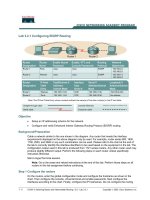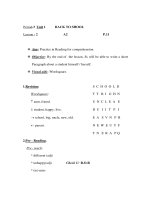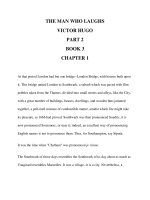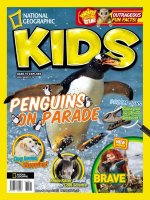3 2 1 penguins on parade (life science)
Bạn đang xem bản rút gọn của tài liệu. Xem và tải ngay bản đầy đủ của tài liệu tại đây (3.66 MB, 12 trang )
Suggested levels for Guided Reading, DRA,™
Lexile,® and Reading Recovery™ are provided
in the Pearson Scott Foresman Leveling Guide.
Genre
Expository
nonfiction
Comprehension
Skills and Strategy
• Main Idea and Details
• Compare and
Contrast
• Graphic Organizers
Life Science
Text Features
•
•
•
•
Captions
Labels
Heads
Glossary
by Morgan Lloyd
Scott Foresman Reading Street 3.2.1
ISBN 0-328-13339-6
ì<(sk$m)=bd dja< +^-Ä-U-Ä-U
Reader Response
1. What is the main idea of this book?
2. Use a graphic organizer like the one
below to compare and contrast two kinds
of penguins you learned about in this
book.
by Morgan Lloyd
3. The word crest has several meanings
other than the one used in this book. Use
a dictionary to find the other meanings.
Write a sentence using the word with one
of these other meanings.
4. What kind of mineral is mentioned
on page 12 in relation to Magellanic
penguins? What does it do?
Editorial Offices: Glenview, Illinois • Parsippany, New Jersey • New York, New York
Sales Offices: Needham, Massachusetts • Duluth, Georgia • Glenview, Illinois
Coppell, Texas • Ontario, California • Mesa, Arizona
The Southern Hemisphere is the natural
home of the world’s penguins. Penguins live
on the Galápagos Islands and in Australia, New
Zealand, Africa, South America, and the islands
that surround Antarctica. They also live on
Antarctica itself.
It is almost impossible for life to exist in
Antarctica.The Sun never rises during the
Antarctic winter.
Antarctica in the winter is the coldest
place on Earth. The temperature dips way
below freezing. Despite that, some living things
make Antarctica home, including the emperor
penguin. The emperor penguin lives and
thrives in Antarctica!
Every effort has been made to secure permission and provide appropriate credit for
photographic material. The publisher deeply regrets any omission and pledges to
correct errors called to its attention in subsequent editions.
Unless otherwise acknowledged, all photographs are the property of Scott Foresman,
a division of Pearson Education.
Photo locators denoted as follows: Top (T), Center (C), Bottom (B), Left (L), Right (R),
Background (Bkgd)
Opener: Getty Images; 1 Getty Images; 3 Brand X Pictures; 5 Corbis; 6 Digital Stock; 7
Fritz Polking/Peter Arnold, Inc.; 8 Digital Vision; 9 David Tipling/Getty Images; 10 Corel;
11 (CL) Digital Vision, (C) Digital Stock, (CR) Corel; 12 Brand X Pictures; 13 ©Comstock
Inc.; 14 Getty Images; 15 Getty Images; 16 Corel; 17 (BL, C, BR) Corel, (B) Digital Stock;
18 ©DK Images
ISBN: 0-328-13339-6
Copyright © Pearson Education, Inc.
All Rights Reserved. Printed in the United States of America. This publication is
protected by Copyright, and permission should be obtained from the publisher
prior to any prohibited reproduction, storage in a retrieval system, or transmission
in any form by any means, electronic, mechanical, photocopying, recording, or
likewise. For information regarding permission(s), write to: Permissions Department,
Scott Foresman, 1900 East Lake Avenue, Glenview, Illinois 60025.
2 3 4 5 6 7 8 9 10 V0G1 14 13 12 11 10 09 08 07 06 05
The continent of Antarctica is one
of Earth’s most isolated places.
3
Why the black suit?
Penguins are dark on the back and white
on the front. This coloring protects them
while swimming.
Predators swimming on the ocean surface
see black when they look down into the dark
water. Penguins’ dark backs help them blend
in with that black color. Predators swimming
deep in the water see white when they look up
into the sky and sunlight. Penguins’ light bellies
help them blend in with that white color.
Special Wings for Swimming
Unlike flying birds, penguins do not have
light bones or flexible wings. That is one of the
main reasons why they cannot fly. Penguins’
bones are dense and strong. Their wings,
which are usually called flippers, are made for
swimming. Penguins’ flippers are very hard and
strong.They do not bend.This lets penguins
swim faster through the water.
Speedy Penguins
Most penguins can swim about fifteen
miles per hour. Some of the larger ones can
swim even faster. By swimming as fast as they
do, penguins are able to leap six feet out
of the water!
Penguin Predators
Penguins have plenty of predators to
watch out for. Sea lions, leopard seals, and
orca whales all hunt and eat adult penguins.
Seagulls and other sea birds will also prey on
penguin chicks. In some places where humans
live nearby, penguin chicks are threatened by
weasels, rats, cats, and dogs.
4
5
Emperor Penguins
Emperor penguins stand about three feet
tall, making them the largest penguins. They
have yellow and orange ear patches. Emperor
penguins live in Antarctica during the winter.
Most amazingly, this is the time they choose
to incubate their eggs!
The female emperor penguin lays a single
egg. As soon as the egg is laid, the female
passes it to her mate. She then goes out to sea
in search of food. Meanwhile, the male emperor
penguin spends two months balancing the
egg on his feet. He warms the egg with his
brood patch, which is a warm patch of
featherless skin.
A group of emperor penguins
diving into the ocean
6
An emperor penguin’s feathers are made to
trap heat.The outer part blocks the wind and
water.The inner fluffy part is called down.
The down traps air close to the penguin,
keeping the penguin warm.
Penguins have a special oil gland near their
tails. They use their beaks to spread oil made
by the gland over their outer feathers. The
oil forms a seal that prevents the penguins’
feathers from getting wet.
A New Coat
Over time a penguin’s feathers become
old and damaged.
So once a year,
penguins molt and
grow a new set of
feathers. It doesn’t
take long for the
new feathers to
grow in. But while
they are growing in,
the penguins must
not get wet, or they
could freeze to
death.
7
Emperor penguins’ flippers and beaks are
smaller than those of other penguins. Because
those body parts are smaller, emperor penguins
lose less body heat.
Emperor penguins breathe very cold
Antarctic air. To make sure they don’t lose too
much heat while they are breathing, emperor
penguins have a special network of passages
inside their beaks. These passages allow them
to save as much as eighty percent of the heat
they would otherwise lose with each breath!
Keeping Warm
Emperor penguins also have a layer of fat
called blubber. The blubber provides energy
for the penguins when they cannot eat. It also
helps keep the penguins warm.
Cold feet?
Emperor penguins reduce heat loss
through their feet by standing on their heels.
This keeps the rest of the foot from touching
the cold ice.
When the temperature is -68°F, it helps to
stick together. Male emperor penguins huddle
to help conserve heat.The temperature in the
middle of an emperor penguin huddle can be
95°F!
Of course, some penguins must stand on
the outside of the huddle. So what do they do
to stay warm? They rotate. The penguins on
the outside gradually push their way into the
middle of the huddle.This way, each penguin
gets a chance to become warmed.
A group of young emperor penguins
warming themselves in a huddle
8
9
Adelie Penguins
Adelie penguins grow to about two feet
in height. Like emperor penguins, Adelie
penguins lay their eggs and raise their young
in Antarctica. However, they do not live in
Antarctica year-round.
Adelie penguins build their nests on rocky
beaches. They build their nests out of pebbles
and lay two eggs. Both parents take turns
keeping the eggs warm and feeding the chicks
when they hatch.
What’s a rookery?
A rookery is a colony of birds or other animals
who have come together to nest and raise
young. An Adelie rookery may have hundreds
of birds nesting in one area.
Young Adelie penguins spreading
their flippers on the shore
10
Penguins’ beaks have different shapes
based on what they hunt and eat.The emperor
penguin’s beak is long and thin for catching
fish.The Adelie penguin’s beak is short and
stubby for catching krill. All penguin tongues
have tiny barbs or spines for keeping a firm
grip on prey they have caught.
Emperor penguin
Adelie penguin
A Crook in the Rookery!
Adelie penguins will give their mates
pebbles when they return to the nest following
a long absence. This often leads to fights, as
Adelies tend to bring back pebbles that they
have stolen from other nests. While an Adelie
penguin is trying to deal with a threat on one
side of the nest, another penguin may make off
with a pebble from the other side!
11
Magellanic Penguins
Magellanic penguins live on the southern
tip of South America and the islands around
Antarctica.They build nests in small burrows
and under bushes. Magellanic penguins feed
mostly on squid, anchovies, and sardines.
One Tough Shell to Crack
The Magellanic penguin’s eggshell is
very thick. Its hard outer part is made of
calcium. Where does this calcium come from?
Magellanic penguins chew on mollusk shells
right before they lay their eggs. The calcium
from the mollusk shells thickens the penguins’
eggshells. Because the eggshell is thicker,
it better protects the baby penguin. It also
helps prevents the egg from cracking on the
hard ground.
Penguins’ bodies trap heat so well that
they are at greater risk of overheating than of
becoming too cold. The Magellanic penguin
stays cool by shedding the feathers around its
eyes in warmer weather. This lets more heat
escape from the body and cools the penguin.
Penguins also cool off by panting, seeking
shade, and lying down on the ice. By spreading
their feathers and holding their flippers away
from their body, they allow heat to escape and
cooling air to move all around them.
Too Much Salt
A lot of sea salt enters
penguins’ bodies.To make
sure that it doesn’t harm
them, penguins have
special glands that remove
salt from the food they eat.
Magellanic penguins gathered on
the shoreline
12
13
King Penguins
The king penguin is the second largest
penguin. It has patches of orange feathers
near its ears. King penguins raise their young
during the summer on the islands surrounding
Antarctica. Like emperor penguins, king
penguins balance their eggs on their feet
instead of building nests.
Square in the Eyes
The pupil is the black opening in the center
of the eye.The king penguin’s eyes have very
unusual pupils. When they narrow, they take on
the shape of a square!
Little Blue Penguin
The smallest penguin in the world is
the little blue penguin. It is also known
as the fairy penguin, the little penguin,
or the blue penguin.The little blue penguin
is only a foot tall. It nests along the southern
coasts of Australia, New Zealand, and on the
Australian island of Tasmania. Instead of making
a nest, the little blue penguin digs a burrow
in the ground.These burrows can be nearly
two feet long.The female little blue penguin
then lays two eggs in the burrow. Both the
male and female little blue penguins help
raise the chicks.
With their orange patches, king
penguins are easy to spot.
The little blue penguin is
unusually small for a penguin!
14
15
Crested Penguins
There are six different species of crested
penguins. A crest is a tuft of feathers that sticks
up from a bird’s head. Crested penguins live
on the islands south of South America, Africa,
Australia, and New Zealand. Crested penguins
vary in size from one to two feet tall.
All crested penguins have similar nesting
habits.They use their sharp claws to dig out
a hole that they line with grass, pebbles,
or sticks.The female crested penguin lays
two eggs. Both the male and female crested
penguins take turns guarding the eggs and
caring for the chicks. Crested penguins eat
krill, squid, and small fish.
Erect-crested penguin
So Many Penguins, So Little Time
From Adelies to Rockhoppers, we’ve now
covered eleven different kinds of penguins.
And that’s barely more than half the total
number of penguin species worldwide!
Emperor penguins get a lot of attention
for being the biggest penguins.They also live in
the worst weather! Still, many other penguins
are just as interesting as the emperor.
All penguins share lives that are tied to the
sea and the Southern Hemisphere’s marine
ecosystems. Penguins cannot fly. But as you
have seen, they are able to get by just fine!
Royal penguin
Macaroni penguin
Rockhopper penguin
Fiordland crested penguin
16
Snares Island penguin
17
Now Try This
Cold Feet
Emperor penguins lose less heat to the ice
by standing and walking on their heels. Using
a metal cookie tray, a freezer, and a sheet of
plastic wrap or wax paper, try this
experiment to see how the
emperor penguins do it!
One warning: Make
sure to step onto the
frozen cookie tray only
after you have placed
the plastic wrap or
wax paper on it.
Otherwise your
feet might stick
to the tray!
to Do It!
w
o
H
s
’
e
r
He
1. Put the cookie tray in the freezer for
at least ten minutes.Take off your shoes and
socks.
2. When you take the cookie tray out of the
freezer, place it on the floor. Cover it with a
sheet of plastic wrap or wax paper. Step on the
cookie tray for a few seconds with your whole
foot touching the tray.
3. Now balance on your heels.You may
need to hold onto a wall for balance. Does
standing on your heels make a difference?
Share what you’ve learned with a friend!
Metal cookie tray
Wax paper
18
Safety scissors
19
Reader Response
Glossary
blubber n. a layer
of fat that stores
energy and provides
insulation.
brood patch n. an
area of skin with few
or no feathers, which
is warmed by blood
vessels in order to
incubate eggs.
crest n. a tuft of
feathers sticking up
from the head of a
bird.
down n. fluffy inner
feathers that trap air
to keep birds warm.
incubate v. to keep
eggs warm so they
will hatch.
1. What is the main idea of this book?
2. Use a graphic organizer like the one
below to compare and contrast two kinds
of penguins you learned about in this
book.
molt v. to grow new
feathers to replace
old feathers.
rookery n. a place
where large groups
of birds or mammals
gather to raise their
young.
3. The word crest has several meanings
other than the one used in this book. Use
a dictionary to find the other meanings.
Write a sentence using the word with one
of these other meanings.
4. What kind of mineral is mentioned
on page 12 in relation to Magellanic
penguins? What does it do?
20









